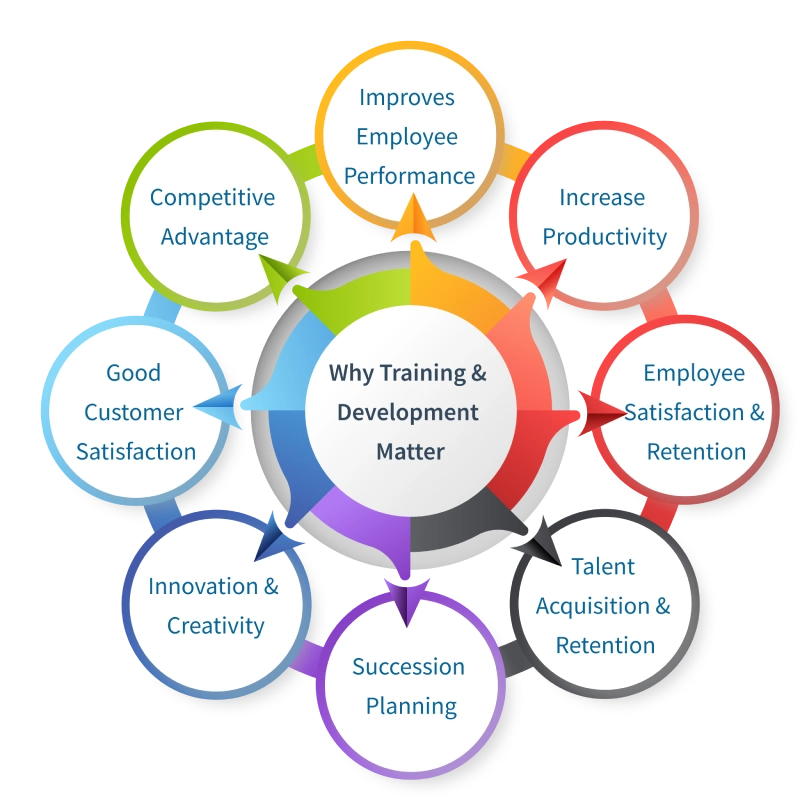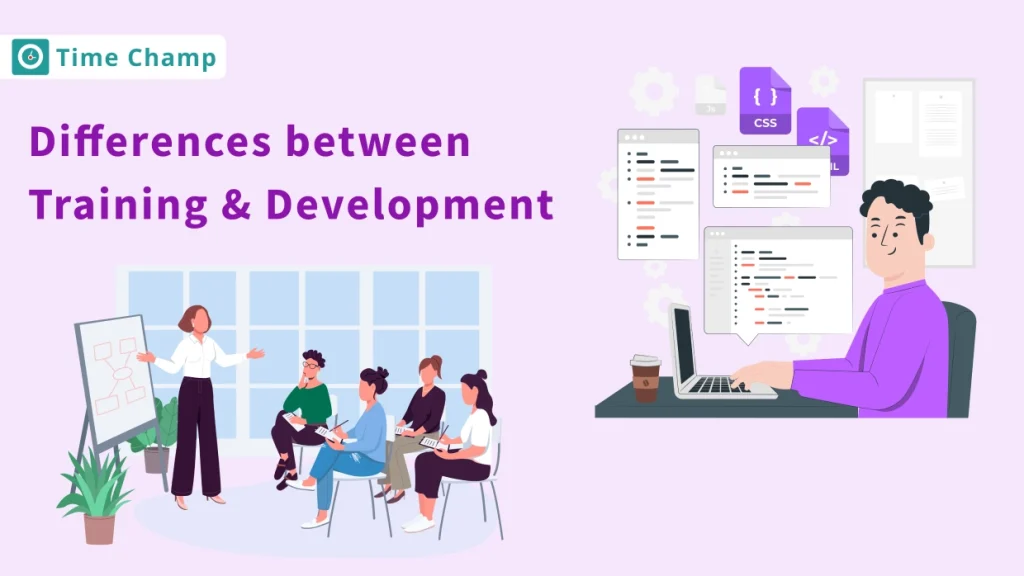What is Training?
Training is the process of teaching employees the knowledge, skills, and abilities they need to do their jobs well. It helps employees improve their work and learn how to handle tasks better. Training usually follows a clear and organized plan to make sure employees know what they need to succeed in their roles. This process plays a key role in improving how a company performs and achieves success.
What is Development?
Development usually helps employees grow both personally and professionally. It offers learning experiences that are intended to improve their abilities and information. These activities not only contribute to the enhancement of performing tasks but also to their long-term career growth and progress.
Why Training and Development Matter

1. Improves Employee Performance
Good training and development help employees gain the necessary skills and knowledge to perform their work effectively. It improves their confidence, which eventually leads to better performance and higher-quality work.
2. Increases Productivity
Well-training and development help employees to improve their productivity. It also helps employees stay engaged and motivated, contributing positively to the overall work environment of the organization.
3. Employee Satisfaction and Retention
When companies provide enough training to employees and give them opportunities to develop their skills, it improves their job satisfaction. It shows that the company cares for its employees’ growth, which eventually improves retention.
4. Talent Acquisition and Retention
Employers who invest in their staff’s professional growth are able to recruit the best employees. Employers find recruitment easier because job seekers are more attracted to companies that offer training.
5. Succession Planning
Training helps find and prepare employees for future leadership roles. Succession planning makes sure the company always has ready leaders to fill important jobs.
6. Innovation and Creativity
Training makes the employees innovative and come up with new ideas. Learning new ways to solve issues helps them find better solutions and improve their work quality as well. In this way, they are able to get a better outcome, enhance their activities and contribute to the company’s development.
7. Good Customer Satisfaction
Trained employees give better service, making customers happier. They can solve customer problems faster, making the whole experience better.
8. Competitive Advantage
It helps businesses keep up with new trends and best practices in the market. When businesses train their staff, they stay prepared for what’s coming next. This is especially important in industries where technology changes fast, and customer needs keep evolving.
What are the Latest Trends in Training and Development?
1. Personalized Learning Paths
Companies are highly focused on meeting the unique needs, preferences, and career goals of employees. These programs usually include self-directed learning, coaching, and customized learning paths. This is because the method is personalized and everyone has a different way of learning; this allows people to remain focused and even enhance memory.
2. Digital Learning
This trend has grown faster after the pandemic. It includes online learning, virtual classes, and learning on mobile devices. Learning management systems allow you to build and deliver both types of programs online depending on your needs. These techniques are flexible and inexpensive, making it simpler to offer training. They also allow employees to learn at their own speed and whenever they have time. This helps employees who work remotely.
3. Micro-Learning
Training is provided in small, manageable chunks through short videos, book summaries, infographics, or quizzes. This approach is suitable for employees who are busy and organizations that wish to provide learning at the right time. It is especially beneficial for employees with tight schedules or those working remotely, allowing them to learn at their own pace and convenience.
4. Gamification
Training becomes somehow fun when games are incorporated into the training program and the use of badges, points, prizes, and challenges encountered in the process of learning. It works best for younger employees who prefer games or interactive learning.
5. Soft skills Development
Training programs help employees learn how to communicate, solve issues, and understand emotions. This helps them perform their job better and support the organization. It makes employees happier, more focused, and sure of their abilities.
Examples of Companies with Training and Development Opportunities
Google offers learning in leadership, technology, and health to its employees. The company’s program is designed to let employees share knowledge and learn from each other in their areas of expertise.
Microsoft
Microsoft has a variety of training solutions including leadership and technical training. Each year, Microsoft holds Hackathons where teams of employees work together on creative solutions.
Amazon
Amazon offers thorough on-the-job training to help employees build skills in areas such as customer service, leadership, and technology. Also, their Career Choice program pays 95% of tuition and fees to help employees acquire skills in the areas of demand.
Frequently Asked Questions
Understanding the difference helps companies to conduct programs. Training helps employees learn the skills they need for their current jobs, while development focuses on building their abilities for long-term career growth.
Some of the challenges that companies face include: how to motivate the employees, how to align the training with the business needs and how to make training available to employees in different parts of the world.
The length of training can be different. Some programs might take only a few hours or days, while others could take weeks or months, depending on what’s being taught.
